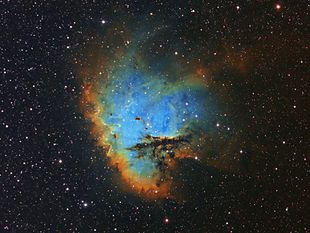NGC 281
| Emission nebula | |
|---|---|
| Data from NGC 281
|
|

|
|
| The emission nebula NGC 281 recorded from Earth. The bright star in the middle is BD + 55 ° 191 (HD 5005). | |
| AladinLite | |
| Constellation | Cassiopeia |
|
Position equinox : J2000.0 , epoch : J2000.0 |
|
| Right ascension | 00 h 52 m 25 s |
| declination | + 56 ° 34 ′ |
| Appearance
|
|
| Apparent brightness (B-band) | 7.3 likes |
| Angular expansion | 35 '× 30' |
| Ionizing source | |
| designation |
IC 1590 , BD + 55 ° 191 (HD 5005) |
| Type | Star clusters with stars of the spectral class O5.5 |
| Physical data
|
|
| Affiliation | Milky Way |
| distance | 9500 ly |
|
history
|
|
| discovery | EE Barnard |
| Date of discovery | November 16, 1881 |
| Catalog names | |
| NGC 281 • IC 11 • LBN 616 • Ced 3 | |
NGC 281 is an emission nebula in the constellation Cassiopeia , 9500 light years from Earth . The fog is recorded in the index catalog as IC 11 and is colloquially referred to as Pac-Man fog because of its similarity to the well-known video game main character of the same name , especially in the English-speaking world . The open star cluster IC 1590 is embedded in NGC 281 , the stars of which are scattered around the center of the nebula and some of which stand out due to their X-rays . The brightest member of IC 1590, the multiple star system BD + 55 ° 191 (HD 5005), is the ionizing source of the nebula. The nebula also contains several Bok globules in which infrared imaging has shown signs of star formation. The molecular cloud , the ionized part of which is the emission nebula, can also be seen in infrared images .
NGC 281 was discovered on November 16, 1881 by the American astronomer Edward Emerson Barnard .
Close-up of a Bok globule in NGC 281 ( Hubble Space Telescope )
The X-ray radiation from the embedded IC 1590 cluster can be seen in violet in the image taken by the Chandra X-ray telescope .
The image from the Wide-Field Infrared Survey Explorer shows the molecular cloud, the ionized part of which can be seen as an emission nebula (blue, left above the center of the image).
Web links
- Hubble Space Telescope
- Cassiopeia constellation
- Astronomie.de
- GoBlack
- Portrait of NGC 281 - Astronomy Picture of the Day December 10, 2008.
- NGC 281: The Pacman Nebula - Astronomy Picture of the Day of August 23, 2005 (English).
- NGC 281: Cluster, Clouds, and Globules - Astronomy Picture of the Day of April 7, 2003.
- Spektrum.de : Collection of amateur recordings
- SIMBAD query
- SEDS
- NASA / IPAC Extragalactic Database
Individual evidence
Attention: The sorting key "NGC 0281" overwrites the previously used key "IC0011".


